JHP Newsletter - 2010, No. 4, 8 September
Greetings from near the North Rim of the Grand Canyon.
We just finished a fantastic Bat Photo Tour, and we're taking some time to get some office work done in a nice scenic location.
Equipment: Visible Dust BriteVue Sensor Loupe 7X
I finally broke down and purchased a Visible Dust BriteVue Sensor Loupe 7X to help with sensor cleaning. It's a 7x loupe (magnifying glass) with LEDs around the perimeter that can be placed on a DSLR camera body to illuminate the sensor. The LEDs provide plenty of illumination in the normally dark mirror chamber, and it's nice to be able to see the dust and then work on that area of the sensor.
Before purchasing it, I just took test shots to look for dust because that was the cheap way to go. However, after some tough dust spots that required many test shots during one cleaning, I purchased the Sensor Loupe. It was money well spent! It's so much faster to look for dust on the sensor with the Sensor Loupe than it is by taking a test shot, downloading the image to a computer, and then looking at the image. If you have been thinking about purchasing a loupe to help with sensor cleaning, don't wait any longer. Rush out and buy a Visible Dust BriteVue Sensor Loupe 7X. You'll wonder why you waited at all.
Travel: Wildlife on Mt. Evans
At the end of June we went to Mt. Evans near Idaho Springs, Colorado, mainly to photograph the Mountain Goat kids and Bighorn Sheep lambs. The road to the top of Mt. Evans is the highest paved road in North America at 14,264 ft or 4348m. The Mountain Goats, in particular, are used to lots of visitors, so it's a great place to photograph them. We had lots of good opportunities to photograph the Mountain Goat kids, and my favorite image is of two of them standing near the top of the mountain with the lower elevations far away in the background (below left). We also had lots of opportunities to photograph Mountain Goat kids with their nannies, and my favorite image is of them standing atop a rock against the sky (below right).
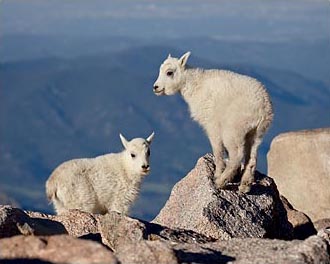
1/1000 sec, f8, ISO 250
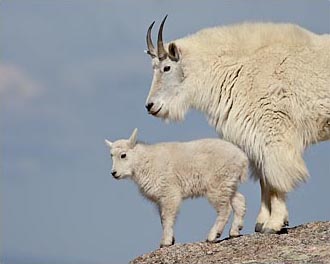
1/2000 sec, f8, ISO 320
While we were there we also photographed some of the smaller, and still common, animals: a Yellowbelly Marmot scratching (below left) and an American Pika posing (below right).
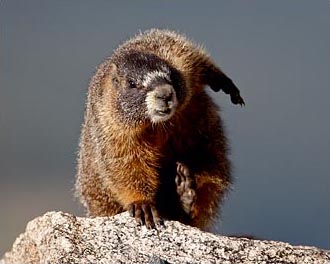
1/750 sec, f8, ISO 320
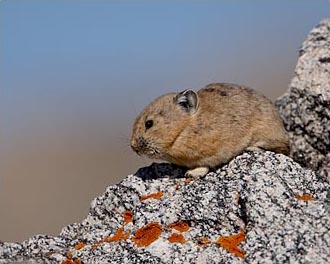
1/1500 sec, f8, ISO 250
We were also fortunate to photograph some less common animals like the White-Tailed Ptarmigan. I was happy to find an elusive male in breeding plumage, and I was excited when he enticed a female to join him. I was ecstatic when they started to mate (below left)! We also came across a Short-Tailed Weasel or Stoat, and I not only got some nice portrait images of it, I also got some nice images of it carrying an American Pika that it had just caught (below right).
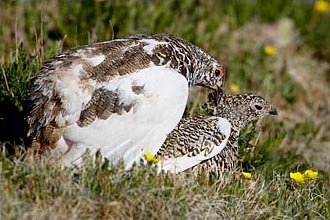
1/1500 sec, f11, ISO 400
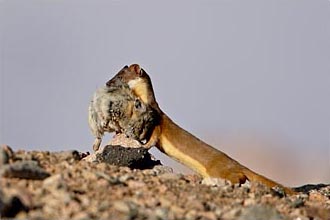
1/1000 sec, f9.5, ISO 400
Travel: Wildflowers In Colorado
We went to Trout Creek Pass southeast of Buena Vista, Colorado, in early July to focus on wildflower photography. We had been invited to stay on some property that belongs to our friends, and we thoroughly enjoyed photographing the wildflowers at nearby Weston Pass. My favorite image from there is of two Blue Columbine, the Colorado State Flower (below left).
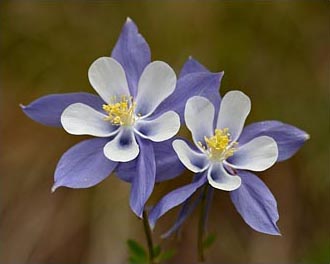
Colorado, USA
1/180 sec, f5.6, ISO 100
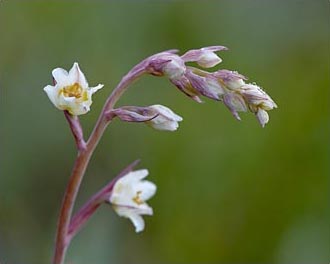
Colorado, USA
1/4 sec, f11, ISO 100
Then we went over Cottonwood pass, west of Buena Vista, and boondocked on the west side for several days. The wildflowers were good on both sides of the pass, and Lodgepole Lupine were blooming in profusion in the forest near where we boondocked. I particularly like this image of a Mountain Death Camas starting to open up (above right).
Then we went to the Crested Butte area for nine nights beginning in mid July. We started near Crested Butte South and Cement Creek, and enjoyed photographing the wildflowers there. We also enjoyed the Broad-Tailed Hummingbirds and Rufous Hummingbirds that came to the feeders we put out. Then we moved to the Gunnison National Forest north of Crested Butte.
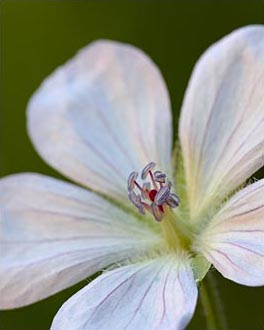
1/2 sec, f11, ISO 100
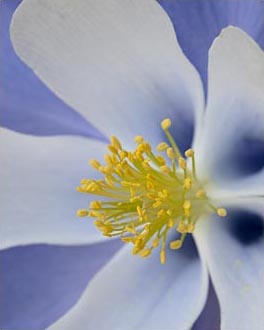
White River National Forest, Colorado, USA
1/2 sec, f16, ISO 100
Most of our wildflower photography had been of individual blooms or clusters of blooms until we hiked up the trail to West Maroon Pass. We were treated to a vast meadow full of wildflowers: Mountain Bluebells, Blue Columbine, Blue Flax, Larkspur, Red Paintbrush, Yellow Paintbrush, Cow Parsnip, and Monument Plant. The image below left shows some of the Blue Columbine and Monument Plant in the Alpine environment. On the hike back to the trailhead, we stopped to photograph some individual Blue Columbine that were in the shade (above right).

White River National Forest,
Colorado, USA
1/125 sec, f11, ISO 100
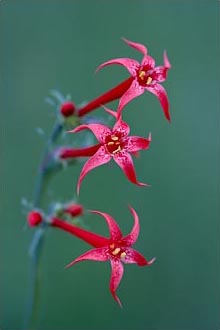
Colorado, USA
0.3 sec, f8, ISO 100
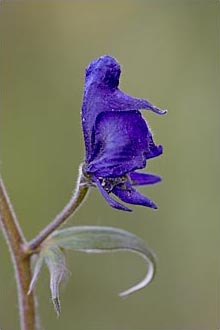
Colorado, USA
1/2 sec, f8, ISO 100
While in the area, I was able to photograph Scarlet Gilia, or Fairy Trumpet, for the first time (above center) and also Western Monkshood (above right), a long-time favorite.
Travel: Moose Near Red Feather Lakes And Gould
In early August, we went to the Red Feather Lakes District northwest of Fort Collins, Colorado, mainly to look for moose. It was our first time in the Red Feather Lakes area, and we loved it there. We found a great place to boondock in the Roosevelt National Forest, and spent 14 nights there. Lots of Broad-Tailed Hummingbirds came to our feeders, and we set up our hummingbird photography setup to photograph them. In the image below left, a female had backed away from the feeder, and you can see her broad (fore and aft) tail. We also photographed at nearby Bellaire Lake and Dowdy Lake. The sunsets weren't fantastic and there were lots of fishermen to avoid, but I like the image (below right) of Dowdy Lake because the large cloud mirrors the large rock in the foreground. I used a 2-stop soft graduated ND (neutral density) filter to help hold back the sky and also a 1-stop soft graduated ND filter to bring up the rock in the foreground.

Roosevelt National Forest,
Colorado, USA
1/125 sec, f19, ISO 320
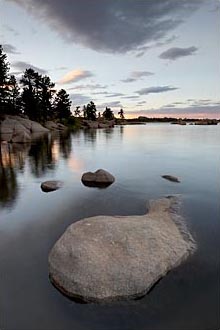
Roosevelt National Forest,
Colorado, USA
3-stops soft grad ND,
1 sec, f16, ISO 100
We only saw a few moose and they were really skittish, so we moved over to near Gould and spent seven nights there. We had many good opportunities to photograph moose, and one day we saw 16 moose — a record. There were four bull moose hanging around the top of Cameron Pass: a real youngster, two good sized bulls (one is below left), and the largest bull I've ever seen in the lower 48. There were also two cows with calves near the top of Cameron Pass, and one had twins. The twins were very active and I wasn't able to get a good image with both of them in it, but I like the image (below right) with one of the twins and its mother.
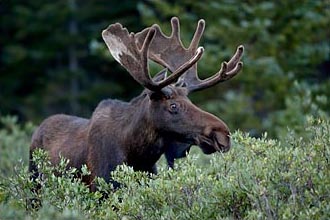
1/20 sec, f5.6, ISO 800
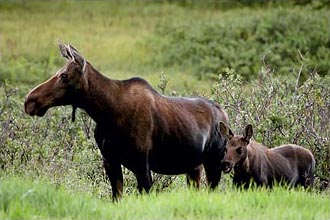
1/60 sec, f8, ISO 800
We also had some cooperative wildlife right at our boondocking spot. The Golden-Mantled Squirrel (below left) must have gone to wildlife modeling school because it sure knew how to work a pose. We had a very territorial female Rufous Hummingbird at our feeders. She would perch on the hanger and not let any other birds come in to feed. So, I put out an aspen branch by the feeder and took her picture on it (below right).
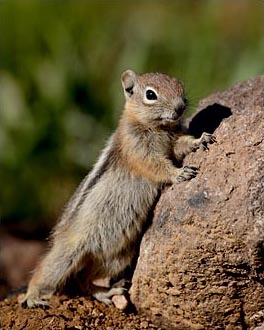
1/750 sec, f8, ISO 200
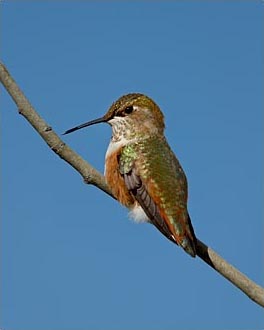
1/500 sec, f11, ISO 400
Travel: Bat Photo Tour
At the end of August, we went to Portal, Arizona, in extreme southeastern Arizona for my bat photo tour. Jan wasn't too interested in going to southern Arizona in the summer, but after she photographed the bats, she was glad she had done so. The plan was to capture bats across the border in New Mexico using mist nets, fly them through a flight tunnel, and then release them when they got tired. When the bats exited the tunnel, they would trip an infrared beam that would trigger a set of flashes to make the exposure. Well, the weather wasn't too cooperative. It was extremely windy when we arrived, and the wind continued into the evening. The wind blew the mist nets around, and that made it easier for the bats to see and/or echo-locate the mist nets and avoid getting caught. I also miss-timed the tour by not considering the phase of the moon. There was a near-full moon on the first night, and the light from the moon illuminated the mist nets making it even easier for the bats to see and avoid them.
The first night we caught just one bat. The Canyon Bat, formerly known as a Western Pipistrel, was a good flier and everyone got some nice images. Because conditions weren't too good for capturing bats, we went to Plan B the second night. We set up an infrared beam and flashes at a watering trough in the Coronado National Forest where our head bat biologist had captured bats recently for scientific studies. (It's illegal to capture bats for commercial purposes in Arizona.) We were able to get some nice images of free-flying bats coming in to drink, but most of the bats were flying the other way. Then we were going to go to the flight tunnel to photograph the bats that our bat biologists had caught, but they didn't catch any so we just packed it in early that night. The third night we used Plan B again. We set up on the other side of the water tank, and almost all of the bats flew the right way for us. :) I got a great shot of a Southwestern Myotis just after it had taken a drink (below left). After we photographed at the tank for about two hours, we went to the flight tunnel and the biologists had four different species for us to photograph. :) First up was a Lesser Long-Nosed Bat, a nectar feeder, and it was the first time I had photographed that species. He was a good flier and we all got nice shots of it (below right).
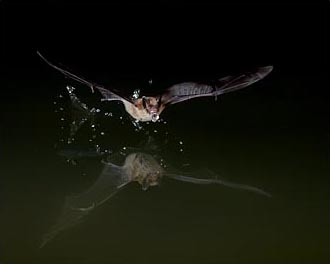
multiple flash, bulb, f11, ISO 200
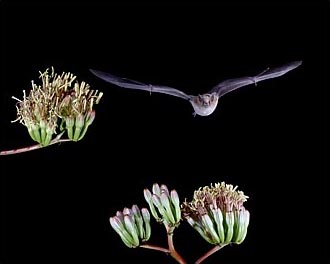
multiple flash, bulb, f19, ISO 100
Then we photographed a Cave Myotis, followed by a Pallid Bat. Pallid Bats have wonderful big ears, and they sometimes land on the ground and then catch scorpions, so we put a scorpion on the rock at the exit of the flight tunnel (below left). The fourth bat was a Mexican Free-Tailed Bat, and we just photographed it while it was on a rock because they don't fly very well through the flight tunnel because they have narrow wings and it takes them longer to start flying than most other bats.
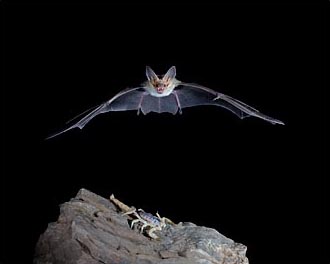
multiple flash, bulb, f16, ISO 100
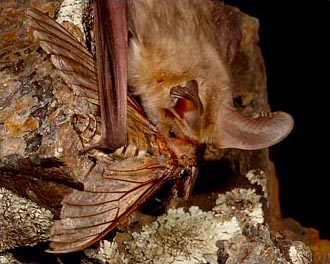
Canon 580EX II and Canon 550EX flashes,
1/60 sec, f22, ISO 100
On the fourth, and last, night, we photographed only at the flight tunnel. We photographed a Big Brown Bat (that's it's name, not a generic descriptor), a Pallid Bat, a California Myotis, and a Canyon Bat. The California Myotis didn't quite understand how the flight tunnel was supposed to work and it spent a lot of time circling inside the tunnel before he would sometimes come out. Then when he did come out, he circled inside the tent instead of landing on the wall or floor like all of the other bats, and it took a while to recapture him before we could send him through the flight tunnel again. After we were done flying the bats, we photographed them either clinging on a rock or being held by one of the bat biologists. I had a ball photographing the Pallid Bat on a rock, especially after we fed him a moth which he devoured (above right).
Take care and happy shooting.
— James
James Hager Photography :: www.jameshagerphoto.com




